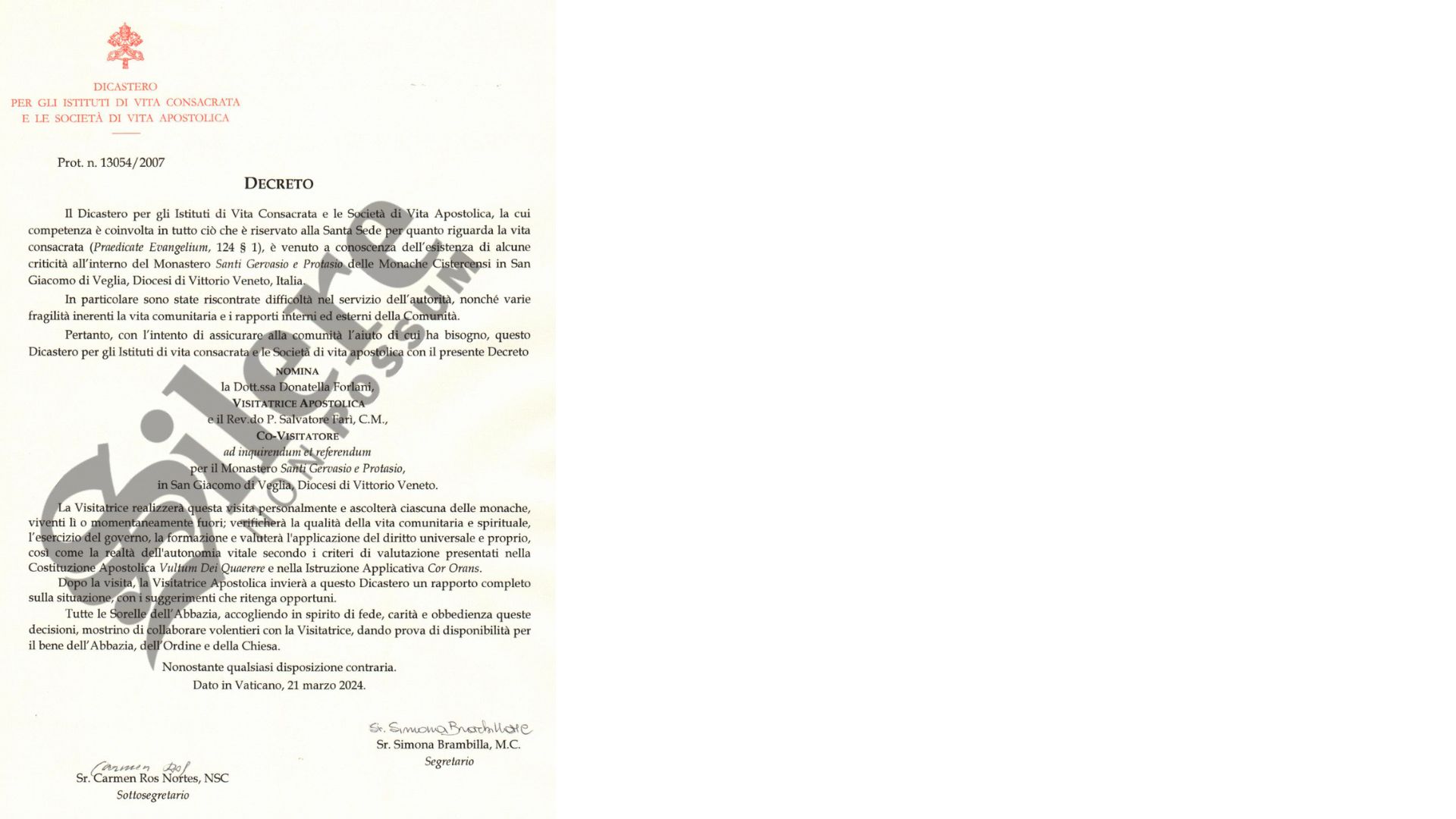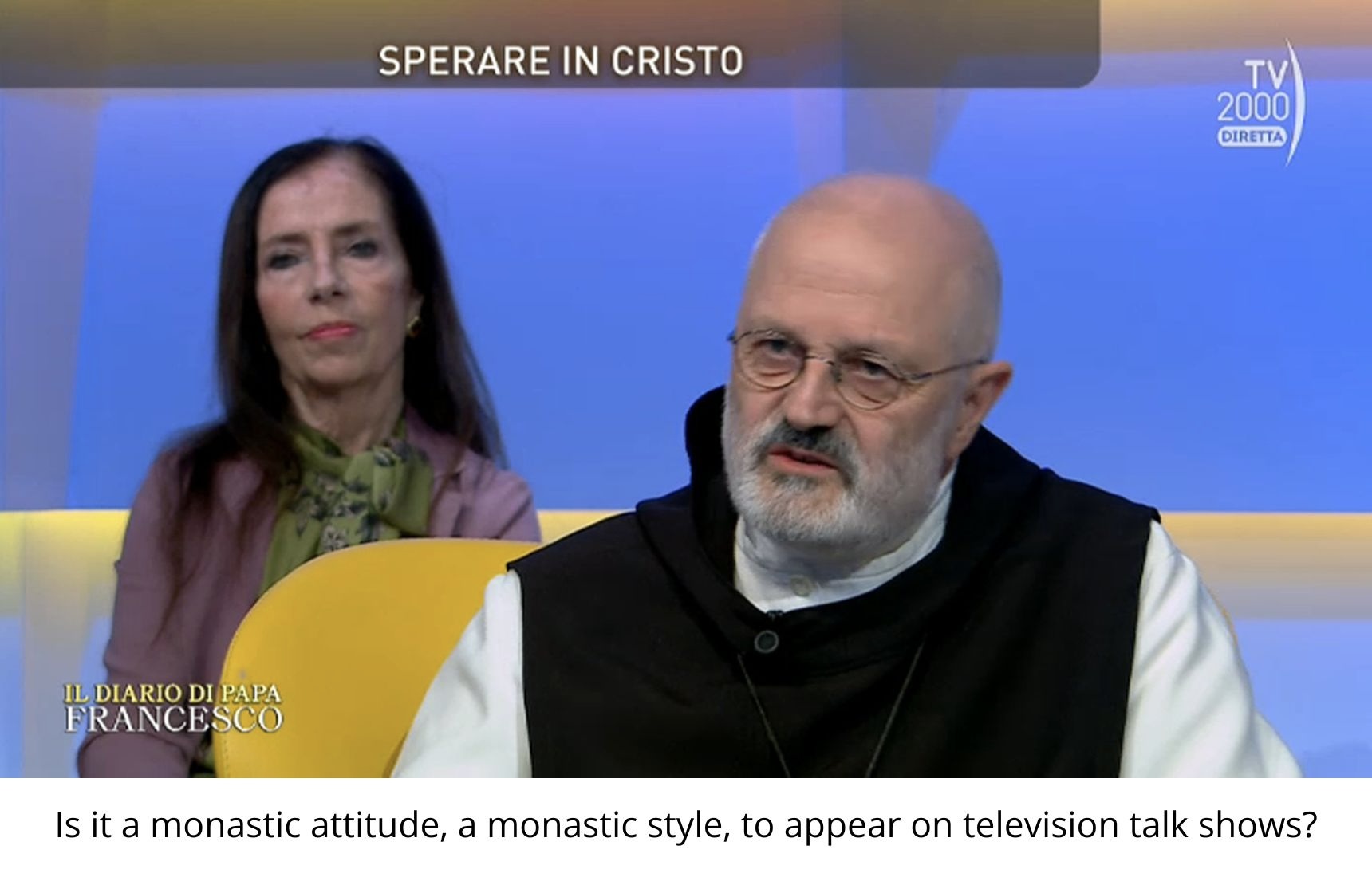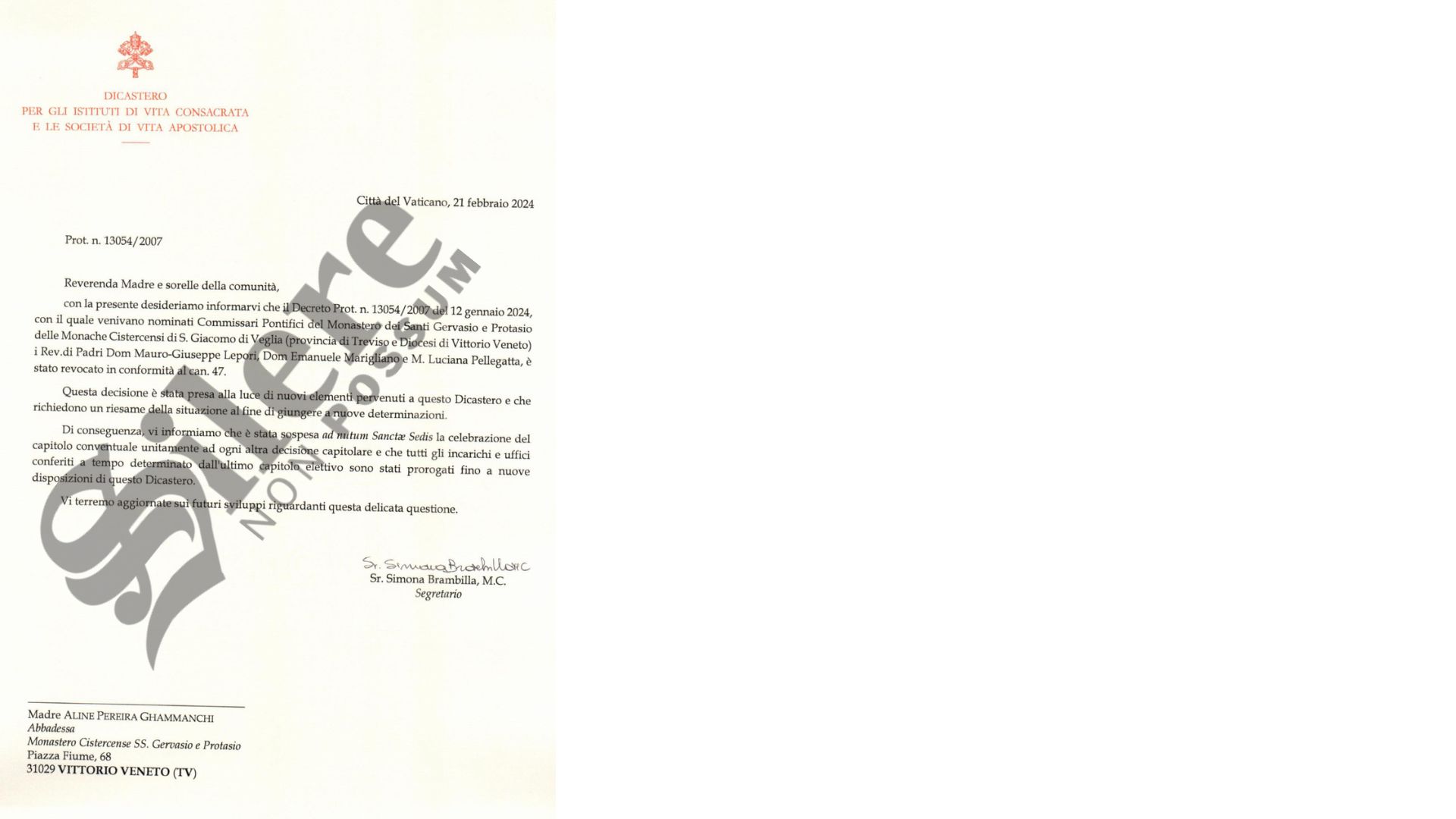Catch up on previous chapters of the survey
🇮🇹 Versione italiana
Vittorio Veneto – The pattern of abuse of power within the Church recurs with unsettling regularity. ‘You know what you have done’: with these words Sister Simona Brambilla addressed Mother Aline Pereira Ghammachi when the latter asked for an explanation of measures that were patently contrary to the law. It was 21 November 2024 and, within the Dicastery, someone murmured—not without trepidation—‘We have seen every colour under the sun since she arrived as Secretary; imagine what it will be like now she is Prefect.’ The words levelled at the Abbess of San Giacomo di Veglia recall the identical ambiguous, accusatory formula that marked the painful affair of the Community of Bose, hastening its slow yet inexorable collapse.
Yet Canon Law—no mere opinion but a fully fledged legal system—allows no room for arbitrary interpretation: it does not envisage that people must ‘intuit’ the charges brought against them. On the contrary, it requires every allegation to be set down in writing, clearly and unequivocally, so that the person concerned can exercise the right of defence in full. On a spiritual level—let us not forget that the Code ends with the phrase salus animarum suprema lex—the absence of genuine engagement with error precludes any possibility of redemption or conversion. This approach reveals something disquieting: even those who currently lead the Dicastery—figures lauded as innovative and as mothers of the psyche—seem not to act with a view to the offender’s recovery and ecclesial reintegration. Indeed, in a curious reversal of what Father Mauro Giuseppe Lepori (himself accused by several monasteries of authoritarian and abusive behaviour) has declared, it is the abbess who has been asked to leave her monastery and relocate elsewhere. Such conduct reflects a toxic style, prone to bending the law to the logic of subjective morality, turning justice into a summary judgement.
As we have already reported, the community has endured a succession of abuses, apostolic visitations and commissariats imposed in dubious fashion. The first visitation, conducted by Mother Ester Stucchi, had already exposed the baselessness of the accusations contained in an anonymous letter sent to the Pope. Not only that: Mother Ester managed to identify the person who had incited the nuns to write that letter. Subsequently Mauro Giuseppe Lepori, Abbot General of the Cistercian Order, had himself appointed commissioner of the monastery, openly flouting every principle of propriety and ignoring glaring conflicts of interest. Fortunately that appointment was revoked at the request of the abbess. Barely months later, in April 2024, a new apostolic visitor was appointed: Donatella Forlani, a figure at the very least questionable, and not only for what she did inside the monastery. A quick online search shows she obtained a Licentiate and Doctorate at the Institute of Psychology of the Pontifical Gregorian University in Rome. We find ourselves, once again, back at square one. The same script seen in the Bose affair is repeated, with Amedeo Cencini centre‑stage. Cencini was defended—indeed, shielded, it must be said—by the Order of Psychologists of Veneto, which hastened to declare that ‘there were no professional breaches in his conduct or words’. Yet the breaches were obvious and, pressed by the media, the Order had to retract several times, eventually taking refuge in the convenient alibi of statutory limitation so as to avoid addressing Cencini’s statements. Curiously, official documents contain no mention of such limitation. Meanwhile Cencini’s videos—we are still obliged to call him ‘psychologist’, with all due respect to a profession that deserves far greater seriousness—remain publicly accessible online.
It should also be remembered that at Bose they called in Anna Deodato, unmasked by Silere non possum for having falsely claimed the title of psychologist, and Enrico Parolari, notorious in Lombardy for the harm caused by his pseudo‑psychological convictions. These practices have lately resurfaced among clergy because of an intervention concerning a priest from Brescia—but we shall deal with that presently. Now, with Donatella Forlani, we face yet another ‘psychologist’ trained at the Gregorian who sets out, disinterestedly and professionally of course, to ‘put things right’ in the latest unfortunate religious community. And we know full well what this entails: a system in which moral convictions and ecclesiastical pressure (from universities and dicasteries) count for more than science, collegial dialogue or respect for the professional code. The examples are too many to list, yet Italian professional orders continue to allow such figures to practise unmolested—in itself proof of guilt.
Alongside Forlani, the Reverend Father Salvatore Farì was appointed as co‑visitor. While the Vincentian priest, after observing the community, judged that there were no insurmountable problems, Forlani’s approach was quite different. The interviews she conducted, described as ‘pseudo‑psychological’ by those subjected to them, lacked the respect owed both to psychology and its ethical code. Alas, nothing new: similar dynamics had already occurred at Bose, executed by other well‑known ‘psychologists’ from pontifical faculties whose theories—often questionable, not to say harmful—the Italian state continues to legitimise through academic recognition.

In Forlani’s case it became clear that her presence in the community fulfilled a specific mandate from the Dicastery for Institutes of Consecrated Life and Societies of Apostolic Life. Although the nuns were—happily—already following individual psychological programmes, Forlani, seemingly the new Freud of the Gregorian, deemed it unnecessary to consult the colleagues already treating the sisters. One might ask: have you ever seen a cardiologist take charge of a patient without even reading the clinical notes or consulting the previous doctor? We certainly have not.
When the visitation by the two delegates concluded (April–July 2024), the nuns were told they ‘needed to intensify formation, increase recreation and devote more time to Eucharistic adoration’. This directive immediately clashes with statements made only days ago by Father Mauro Giuseppe Lepori on the television italian programme Pomeriggio Cinque. The Abbot had criticised the nuns for promoting wine production in ways he deemed ‘not very monastic’. Here, however, the community is expressly asked to expand opportunities for recreation.
The words of a cardinal renowned for goodness and spiritual depth spring to mind. Referring to the atmosphere in seminaries, especially between 2013 and 2025, he lamented: ‘If you are A, they tell you that you should be B. If you are B, you must become A. Such formation is sheer madness.’ This tendency, increasingly evident in recent years, typifies those determined to spot problems at any cost among the consecrated. Certainly every man or woman has rough edges to smooth and a personal path of sanctification to tread, but the obsessive search for ‘something wrong’ is typical of narcissistic formators who want, at all costs, to leave their mark on those they form—whether monk or priest—so as to claim credit for a supposed change (all too often negative). ‘They would find fault even with Saint Aloysius Gonzaga,’ the cardinal noted wryly. Despite everything, the Abbess and the nuns took the advice on board, enrolling in courses at Sant’Anselmo in Rome and implementing the other requests as well.

The narcissism of Mauro Giuseppe Lepori
In recent days Mauro Giuseppe Lepori granted an interview to Pomeriggio Cinque, choosing as backdrop the cloister of the general house on the Aventine. The interview, of course, was arranged down to the last detail: the journalist—visibly subservient—restricted herself to the questions Lepori had insisted upon. No contradictions, no real probing, no depth. It would have been legitimate to ask the Abbot General why he did not think it proper to refrain from judgement and involvement in the affair, given his personal relationship with the abbess. The journalist did not even hint at the messages and e‑mails published by Silere non possum (which she said she had read) that moved the Dicastery to revoke his appointment as Pontifical Commissioner. Nothing. Total silence. Even from the Swiss abbey whence Lepori hails, observers note this manner of acting is sadly habitual. Many remark that they were glad to see the back of him when he went to Rome.
In November 2024 Sister Simona Brambilla—lauded by certain media as a kind of ‘new Pentecost’ simply for being a woman, as though competence depended on biological sex—contacted Mother Aline Pereira Ghammachi, informing her that Donatella Forlani would visit for a private meeting. Forlani wished to see the abbess in secret, away from the community’s eyes. The mother, however, firmly refused, saying she had never left the monastery without good reason or without informing her sisters. An attitude which, by Lepori’s own logic, ought to be considered ‘very monastic’. Evidently even that was no longer acceptable. ‘If you are A, you must be B’—let us recall—is the hallmark of conscience abuse. Eventually Forlani agreed to meet the abbess in a secluded part of the monastery. There, without preamble, she declared: ‘You must leave the monastery.’ The mother asked for explanations, pointing out she had never received any formal accusation, no official act, no evidence of supposed failings—only the peremptory order to depart.
It is important to note that, contrary to Lepori’s public—and false—claims, Mother Aline Pereira Ghammachi had been duly elected by the community and her term had expired naturally. A new election in Chapter should therefore have been held. Since only four nuns had expressed dissatisfaction with her leadership, a reconfirmation was more than plausible. That was probably what worried Lepori. Not so the Dicastery, which—as documents in our possession show—had extended all offices, including that of abbess, so that the situation could be examined more thoroughly. Internal sources at the Dicastery in Piazza Pio XII state that ‘very little was clear, because Lepori displayed a suspicious haste, an almost feverish desire for everything to be settled with the utmost speed.’ Further proof that Lepori’s recent statements to the media contain objectively false elements.

Brambilla and female abuses—no different from male ones
On 21 November 2024 Mother Ghammachi entered the Dicastery for Consecrated Life and Societies of Apostolic Life, seeking clarification from Prefect Sister Simona Brambilla about the decision concerning her. To her legitimate request she received the terse, allusive reply: ‘You know why. You know what you have done.’ A response of this kind, devoid of objective elements or references to canonical norms or concrete facts, unfortunately echoes dynamics typical of contexts where power is exercised abusively, lacking transparency and blatantly violating not only canon law but also the principles of evangelical fraternity. The gravity is heightened by the fact that Sister Brambilla has often claimed special competence in psychological dynamics and the guidance of consecrated life. Yet here—as on previous occasions—her conduct is anything but exemplary, causing serious concern. A significant precedent is the Sant’Anselmo Case on the Aventine: despite numerous reports of grave authority abuses and bullying towards a Polish abbot and lecturer, the Dicastery failed to intervene. It is documented that the abbot’s personal belongings were thrown into a corridor and parlour in a blatant act of intimidation and humiliation. Faced with such facts, the Prefect took no public action of condemnation or protection, thereby offering, in effect, silent endorsement of practices alien to justice and Christian charity. Such management—systematically avoiding transparent confrontation and respect for ecclesial norms—undermines the institution’s credibility and mortifies the trust of many consecrated persons who turn to the Holy See in hope of justice and hearing. The meeting yielded no concrete result, and on Good Friday, 18 April 2025, a new decree was served on the Mother appointing Reverend Sister Martha Elisabeth Driscoll O.C.S.O. as Pontifical Commissioner, assisted by two ‘counsellors’: Reverend Sister Luciana Pellegatta and Donatella Forlani. One must ask why all those who had delivered a positive judgement—Father Zanolini, Mother Stucchi, Mr Testa and Father Farì—have been removed from their posts and sidelined. It should be noted from the outset that Sister Driscoll, esteemed even by Silere non possum for some interventions on priestly life, is 81 years old and appears to lack the physical energy and clarity required to guide a monastic community deeply scarred by internal tensions, rifts and divisions. Moreover—no minor matter—she maintains a close relationship (closer than the ‘Strict Observance’ suggests!) with Mauro Giuseppe Lepori, compromising her impartiality and capacity for balanced action. Even now Sister Driscoll seems to act in ways long denounced by many nuns in women’s monasteries: marked authoritarian and punitive attitudes amounting to genuine psychological pressure. She is exerting strong pressure on Mother Aline Pereira Ghammachi to request a dispensation from her religious vows, thereby abandoning monastic life. It was Driscoll who asked the oblate interviewed by Italian television to leave the monastery. The American nun is also working in concert with Father Lluc Torcal, Procurator General of the Cistercian Order and staunch ally of Lepori, in order to give ‘continuous lectures to the monastic community so as to brainwash them on “unity”.’ The ‘unity’ preached by these people is precisely what Father Dysmas De Lassus, in his book on abuses in religious life, defines as uniformity. Again returning to the Bose affair, whose scheme is replicated here, there too they began to give lectures led by Amedeo Cencini, Enrico Parolari and Anna Deodato. The monks remarked: ‘They treat us like idiots, making us play little games that they claim reveal great truths about our personality.’
This, after all, is how the circle around Cencini and his long‑time supporters has used psychology in the Church: ‘If you blink you are mad, if you move your feet you are a paedophile, if you touch your nose you are aggressive, if you scratch your shoulder you are a lesbian.’ Professional orders are, of course, silent, and monks, nuns, seminarians and religious continue to fall victim to these psychopaths who call themselves psychologists.
Returning to San Giacomo, Mother Driscoll also contests the abbess’s decision to move temporarily to a house in Vittorio Veneto, motivated solely by proximity to and support from her family after the treatment she had suffered. This recalls numerous other cases of priests, seminarians, monks and nuns who are systematically marginalised or bullied until they are forced to leave the community, with no support or accompaniment offered, despite such provision being explicitly required by Canon Law.
The pressure exerted by Sister Driscoll constitutes blatant mobbing of a nun already badly shaken and visibly frightened, at a moment of deep personal and spiritual turmoil. It is worth noting that there are undisputed documents signed by the Carabinieri of the Vittorio Veneto station who, on 26 April 2025, recorded Mother Ghammachi’s formal complaint‑report. As happened at Bose, we witness the forced imposition of distance between nuns, exceeding the Church’s guiding role and becoming outright manipulation of consciences. Added to this is the scornful manner in which Driscoll greeted Mother Ghammachi’s decision to seek legal recourse, both civil and canonical. ‘You want to continue a conflict just to prove that the Church has acted unjustly towards you, not because you wish to be reinstated, but only to prove you are right,’ Driscoll asserted. Such a statement not only distorts the nun’s true intentions but reveals a worrying tendency to identify herself with the institutional Church, thereby legitimising abusive, self‑referential behaviour. In reality, the nuns involved do not claim that ‘the Church’ acted unjustly; they denounce the specific responsibilities of well‑defined individuals: Mauro Giuseppe Lepori, Donatella Forlani and now Elisabetta Driscoll. Otherwise they would have turned elsewhere and not to the Apostolic Signatura, which is itself an expression of the Church.
All this takes place, finally, in a clear attempt to protect the four sisters who slandered the abbess and her companions: a most serious accusation that, nevertheless, has entailed no consequence for its authors, evidently shielded by Lepori, who, it should be remembered, is spiritual director to some of them.
But the affair does not end here.
p.M.A.
Silere non possum